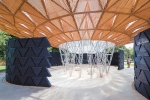Under the Crown of a Tree
>
Diébédo Francis Kéré, the award-winning architect from Gando, Burkina Faso, designed the Serpentine Pavilion 2017, responding to the brief with a bold, innovative structure that brought his characteristic sense of light and life to the lawns of Kensington Gardens. Since its launch in 2000, this annual commission of an international architect to build his or her first structure in London at the time of invitation has become one of the most anticipated events in the global cultural calendar and a leading visitor attraction during London’s summer season. Inspired by the tree that serves as a central meeting point for life in his home town of Gando, Francis Kéré designed a responsive Pavilion that sought to connect its visitors to nature – and each other. An expansive roof, supported by a central steel framework, mimicked a tree’s canopy, allowing air to circulate freely while offering shelter against London rain and summer heat. Kéré positively embraced British climate in his design, creating a structure that engaged with the ever-changing London weather in creative ways. The Pavilion had four separate entry points with an open air courtyard in the center, where visitors could sit and relax during sunny days. In the case of rain, an oculus funneled any water that collected on the roof into a spectacular waterfall effect, before it was evacuated through a drainage system in the floor for later use in irrigating the park. Both the roof and wall system were made from wood. By day, they acted as solar shading, creating pools of dappled shadows. By night, the walls became a source of illumination as small perforations twinkled with the movement and activity from inside.
As an architect, Kéré is committed to socially engaged and ecological design in his practice, as evidenced by his award-winning primary school in Burkina Faso, pioneering solo museum shows in Munich and Philadelphia, and his immersive installation in the 2014 exhibition Sensing Spaces at London’s Royal Academy.
SERPENTINE GALLERIES


